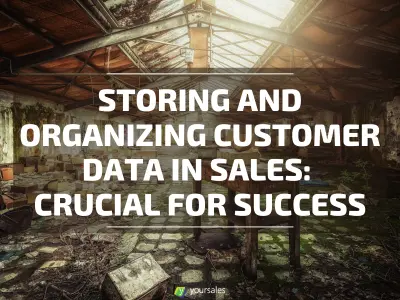Storing and Organizing Customer Data in Sales:
Crucial for Success
In the ever-evolving world of B2B sales, storing and organizing customer data is made difficult by the exponential growth in information volume and complexity. As a result, it has become a paramount concern for sales teams and their organizations.
This article is part of the series where we identify the top 5 problems sales leaders want Customer Relationship Management (CRM) systems to solve, what those problems really are, and the value of solving them.
We’ve finally arrived at problem #1. The big one: Storing and Organizing Customer Data.
In this article, we will delve into the fundamental aspects of storing and organizing customer data, exploring why it is of utmost importance for the success of B2B selling companies.
What’s in this article?:
If you want to see what the other top 5 problems sales leaders want to solve are, then just follow the link.

Want to revisit the other top 5 problems? Then you’ll find the other articles in the series here:
- #2: Sales Forecasting: A Strategic Imperative
- #3: Capturing Client & Prospect Communication: Unveiling the Powerful Key to Sales Success
- #4: Building and Growing Existing Accounts: The Vital Role of CRM
- #5: Data & Insights in CRM: Empowering Leaders and Teams
Understanding Storing and Organizing Customer Data
Definition and Scope
Storing and organizing customer data refers to the collection, management, storage, and categorization of information about customers and prospects. This data encompasses a broad range of details, including contact information, purchase history, preferences, interactions, and other relevant information that can be used to understand and engage with customers effectively.
Data Types
Customer data can be classified into two main types: structured and unstructured. Structured data is organized and formatted, typically residing in databases and spreadsheets. It includes customer names, addresses, phone numbers, and purchase records. On the other hand, unstructured data is less organized, consisting of customer emails, chat logs, social media interactions, and customer support tickets.
Part of the challenge of storing and organizing customer data is to put structure to as much information as possible. This goes as well for all the inherently unstructured data types.
Data Sources
Customer data can originate from various sources, such as customer relationship management (CRM) systems, marketing automation platforms, a long range of sales tools, social media platforms, and customer support software. Effective data storage and organization involve integrating data from these disparate sources into a centralized system to ensure a comprehensive view of customers. To ensure a single source of truth!
The Importance of Storing and Organizing Customer Data
Personalized Customer Experiences
Storing and organizing customer data enables sales teams to gain deep insights into customers’ preferences, behaviors, and pain points. With a comprehensive understanding of individual customers, sales representatives can personalize their interactions, tailoring their pitches, offerings, and engagement strategies to meet specific customer needs. This personalized approach not only enhances customer satisfaction but also improves conversion rates and customer loyalty.
At a macro level, storing and organizing customer data enables analysis, which provides into buyer persona preferences. This in turn enables improved marketing and sales communication.
Effective Sales Forecasting and Planning
Accurate sales forecasting and planning are vital for any B2B company. By organizing customer data, sales teams can identify patterns, trends, and buying behaviors, enabling them to make data-driven sales projections. This information helps companies optimize inventory, allocate resources effectively, and plan marketing campaigns strategically. Accurate forecasting mitigates risks, ensures optimized sales operations, and facilitates proactive decision-making.
Targeted Marketing and Lead Generation
Organized customer data empowers sales and marketing teams to segment customers effectively, enabling them to create targeted marketing campaigns. By categorizing customers based on demographics, preferences, purchase history, and other factors, B2B companies can tailor their messaging and promotions to resonate with specific customer segments. This targeted approach not only improves lead generation but also enhances customer engagement and conversion rates.
Streamlined Customer Support and Issue Resolution
An essential aspect of organizing customer data is capturing and storing information related to customer interactions and support requests. With a well-structured data repository, sales teams can quickly access historical data, including previous inquiries, issues, and resolutions. This facilitates efficient customer support, enabling representatives to provide personalized and timely responses, resulting in improved customer satisfaction and loyalty.
Competitive Advantage
In today’s competitive landscape, data has emerged as a valuable asset. B2B companies that effectively store and organize customer data gain a competitive advantage by leveraging insights and analytics to drive decision-making. By capitalizing on customer data, sales teams can identify market trends, stay ahead of competitors, and develop innovative solutions that meet evolving customer needs.
Best Practices for Storing and Organizing Customer Data
Centralized Data Repository
Centralizing customer data is key to effective organization and accessibility. Implementing a robust CRM system allows for the integration of data from multiple sources into a single repository. This centralized approach enables sales teams to have a holistic view of customers, streamlines data management, and avoids duplication or fragmentation of data.
Automation and Integration
Leveraging automation and integrating various systems and tools can significantly enhance the efficiency and accuracy of storing and organizing customer data. Automation reduces manual data entry, improves data consistency, and eliminates human errors. Integrating CRM systems with other sales tools, marketing automation platforms, analytics tools, and other applications facilitates seamless data flow and enables real-time updates.

Data Governance and Standardization
Defining data governance policies and standardizing data formats and structures are essential for consistent organization and efficient data management. Establishing data entry protocols, naming conventions, and data validation processes ensures that the data remains accurate, up-to-date, and easily searchable. Governance also involves regularly cleansing and de-duplicating data to maintain its quality.
Data Security and Privacy
Data security and privacy are critical when it comes to storing and organizing customer data. B2B companies should ensure compliance with applicable data protection regulations and implement robust security measures to protect customer information from unauthorized access, breaches, or misuse. Regular audits, encryption, access controls, and secure storage practices should be employed to safeguard customer data.
Conclusion
Storing and organizing customer data is a vital function for sales teams in B2B companies. It empowers sales reps with the insights they need to personalize customer experiences, forecast sales accurately, target marketing efforts, streamline customer support, and gain a competitive advantage. By implementing best practices and prioritizing information security, B2B companies can unlock the full potential of their customer data, paving the way for long-term success in today’s dynamic business landscape.


